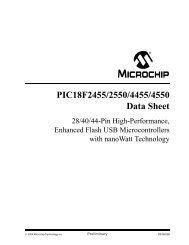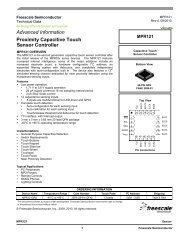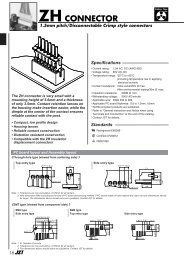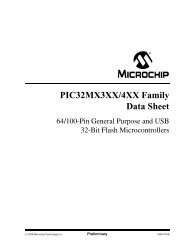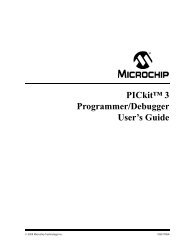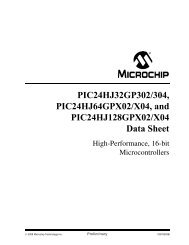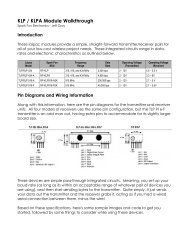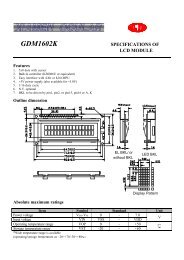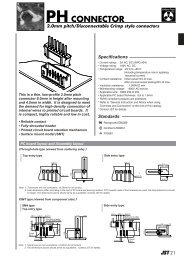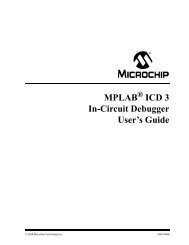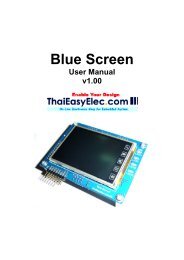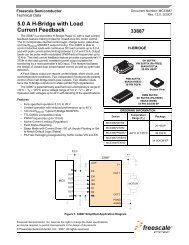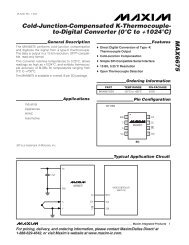SC16IS740/750/760 Single UART with I2C-bus/SPI interface, 64 ...
SC16IS740/750/760 Single UART with I2C-bus/SPI interface, 64 ...
SC16IS740/750/760 Single UART with I2C-bus/SPI interface, 64 ...
Create successful ePaper yourself
Turn your PDF publications into a flip-book with our unique Google optimized e-Paper software.
NXP Semiconductors<br />
<strong>SC16IS740</strong>/<strong>750</strong>/<strong>760</strong><br />
<strong>Single</strong> <strong>UART</strong> <strong>with</strong> I 2 C-<strong>bus</strong>/<strong>SPI</strong> <strong>interface</strong>, <strong>64</strong>-byte FIFOs, IrDA SIR<br />
16. Handling information<br />
<strong>SC16IS740</strong>_<strong>750</strong>_<strong>760</strong>_6<br />
Inputs and outputs are protected against electrostatic discharge in normal handling.<br />
However, to be completely safe you must take normal precautions appropriate to handling<br />
integrated circuits.<br />
17. Soldering of SMD packages<br />
This text provides a very brief insight into a complex technology. A more in-depth account<br />
of soldering ICs can be found in Application Note AN10365 “Surface mount reflow<br />
soldering description”.<br />
17.1 Introduction to soldering<br />
Soldering is one of the most common methods through which packages are attached to<br />
Printed Circuit Boards (PCBs), to form electrical circuits. The soldered joint provides both<br />
the mechanical and the electrical connection. There is no single soldering method that is<br />
ideal for all IC packages. Wave soldering is often preferred when through-hole and<br />
Surface Mount Devices (SMDs) are mixed on one printed wiring board; however, it is not<br />
suitable for fine pitch SMDs. Reflow soldering is ideal for the small pitches and high<br />
densities that come <strong>with</strong> increased miniaturization.<br />
17.2 Wave and reflow soldering<br />
Wave soldering is a joining technology in which the joints are made by solder coming from<br />
a standing wave of liquid solder. The wave soldering process is suitable for the following:<br />
• Through-hole components<br />
• Leaded or leadless SMDs, which are glued to the surface of the printed circuit board<br />
Not all SMDs can be wave soldered. Packages <strong>with</strong> solder balls, and some leadless<br />
packages which have solder lands underneath the body, cannot be wave soldered. Also,<br />
leaded SMDs <strong>with</strong> leads having a pitch smaller than ~0.6 mm cannot be wave soldered,<br />
due to an increased probability of bridging.<br />
The reflow soldering process involves applying solder paste to a board, followed by<br />
component placement and exposure to a temperature profile. Leaded packages,<br />
packages <strong>with</strong> solder balls, and leadless packages are all reflow solderable.<br />
Key characteristics in both wave and reflow soldering are:<br />
• Board specifications, including the board finish, solder masks and vias<br />
• Package footprints, including solder thieves and orientation<br />
• The moisture sensitivity level of the packages<br />
• Package placement<br />
• Inspection and repair<br />
• Lead-free soldering versus SnPb soldering<br />
17.3 Wave soldering<br />
Key characteristics in wave soldering are:<br />
© NXP B.V. 2008. All rights reserved.<br />
Product data sheet Rev. 06 — 13 May 2008 57 of 62



